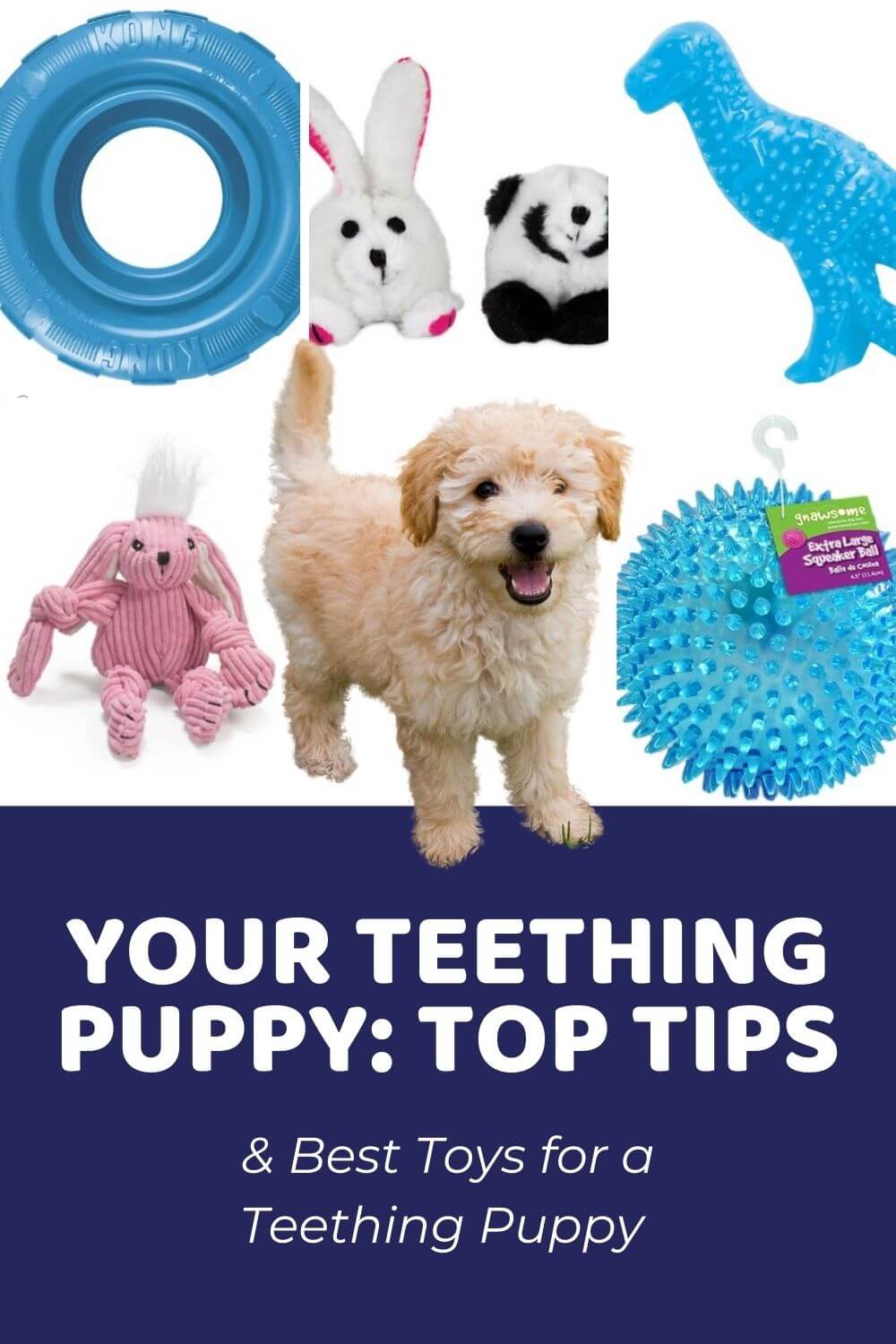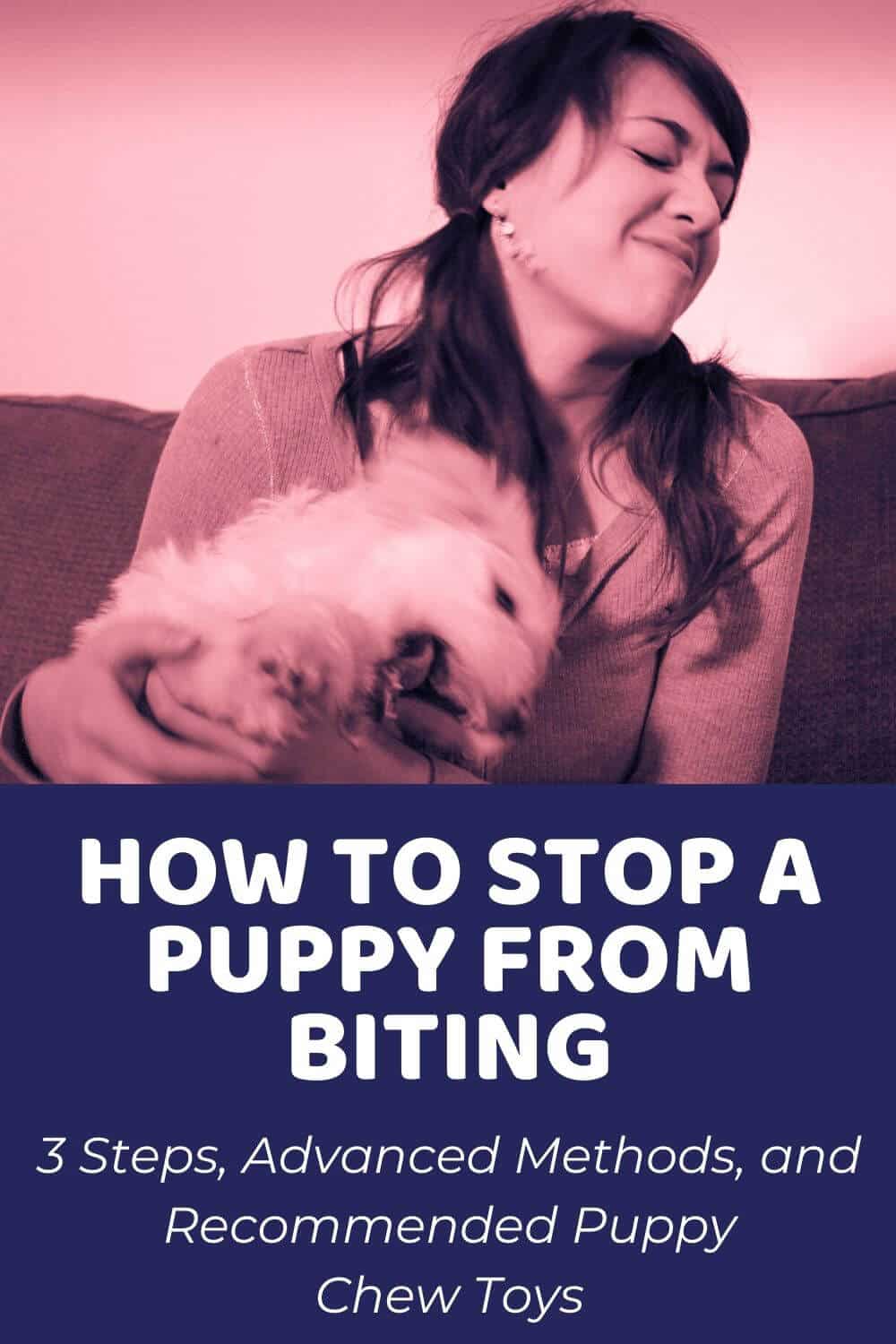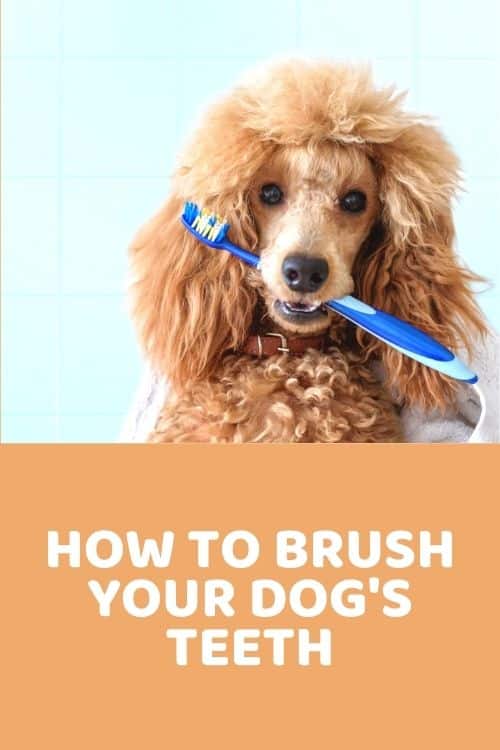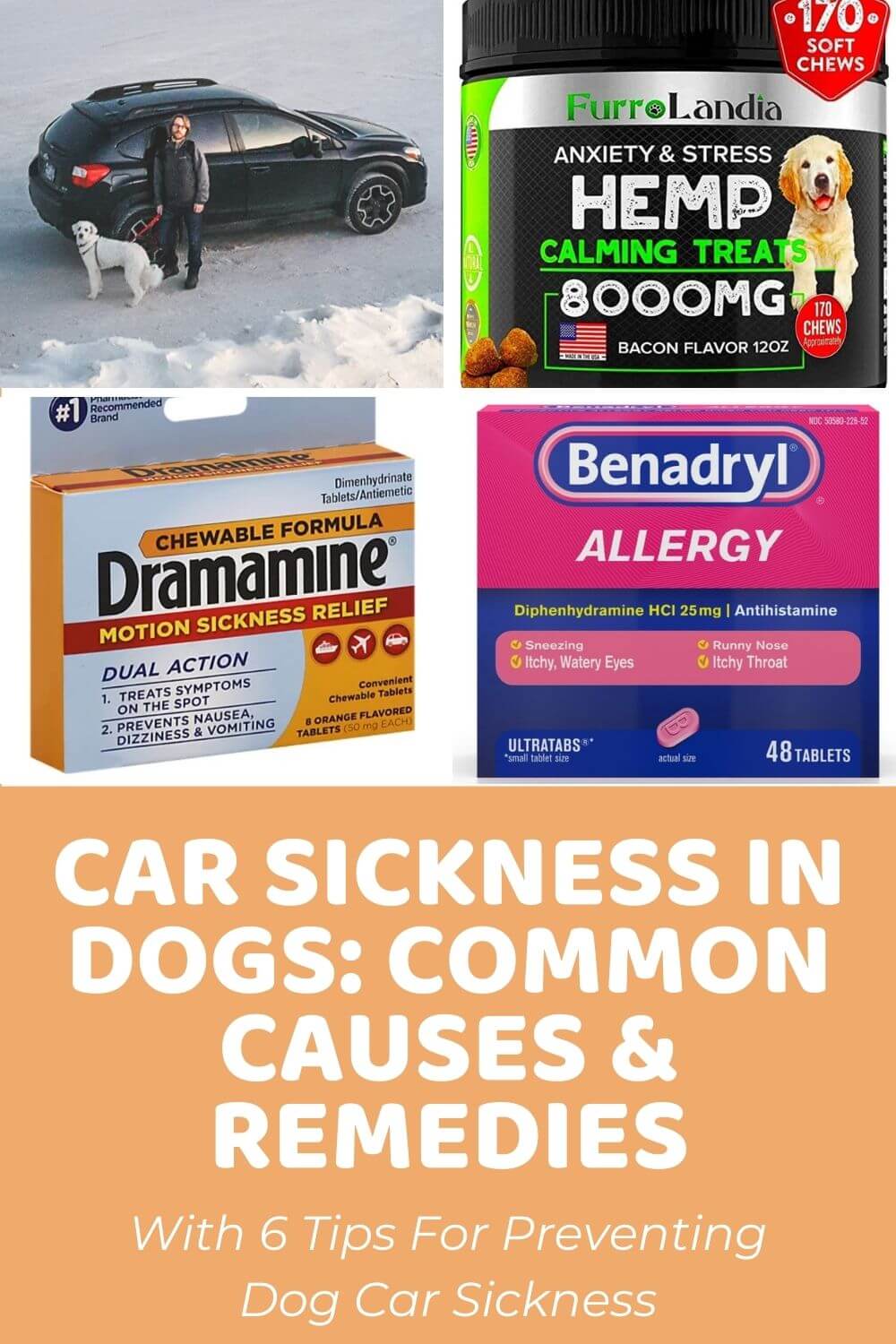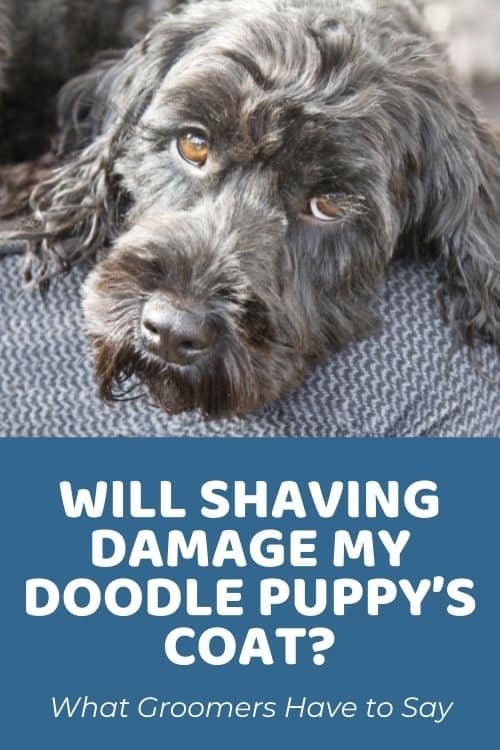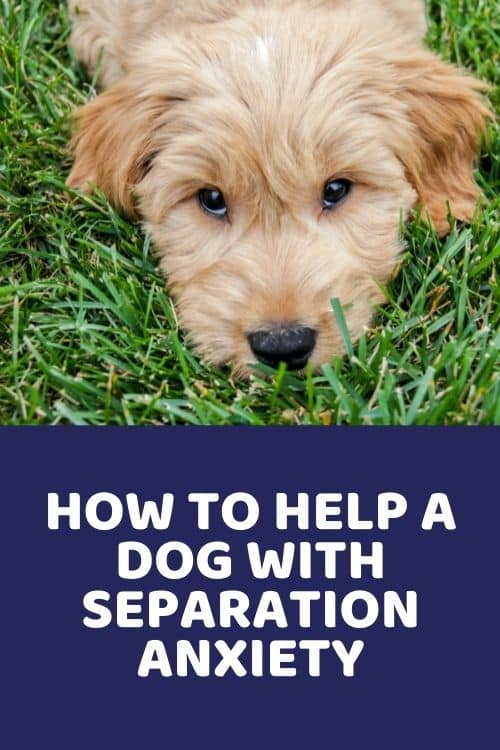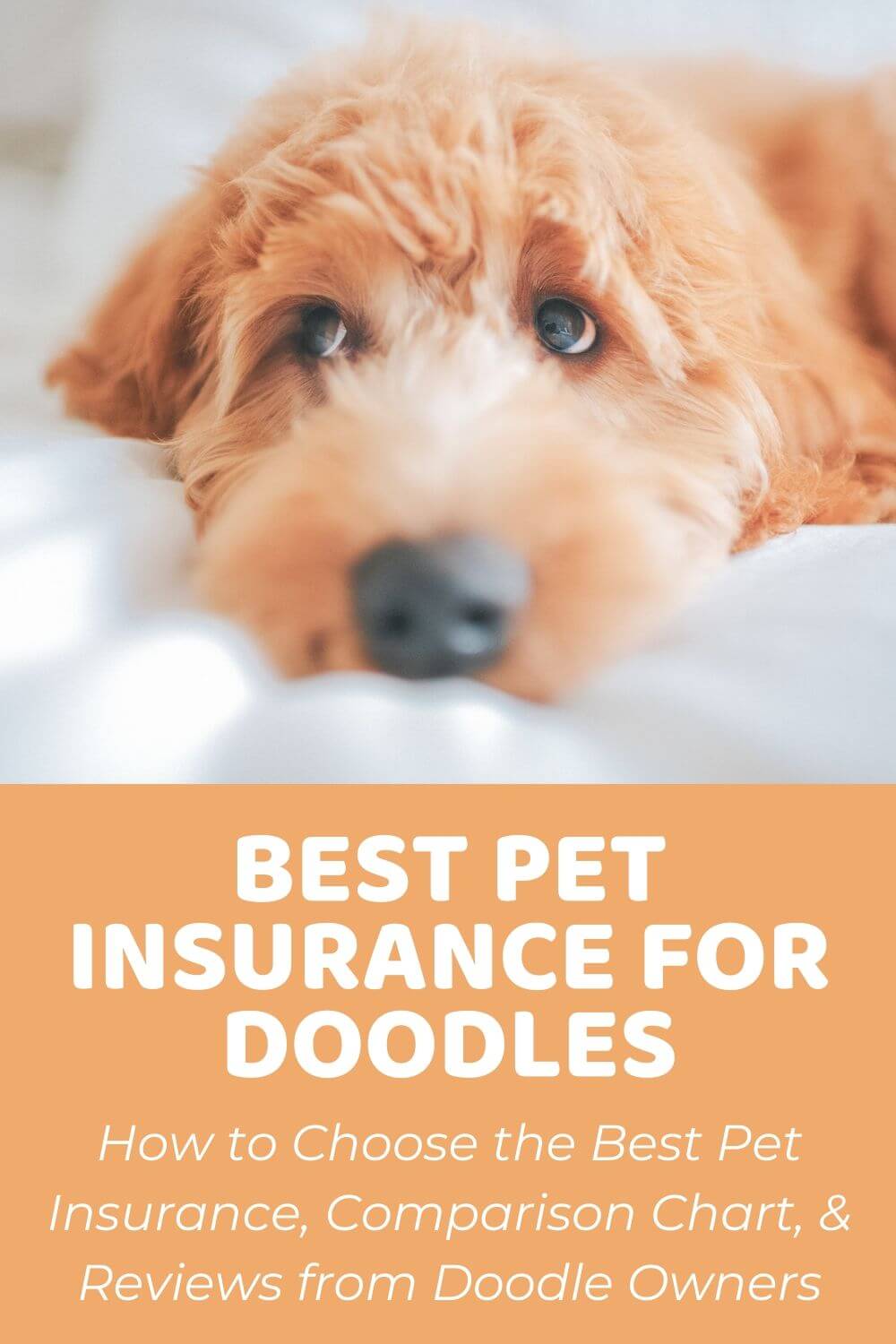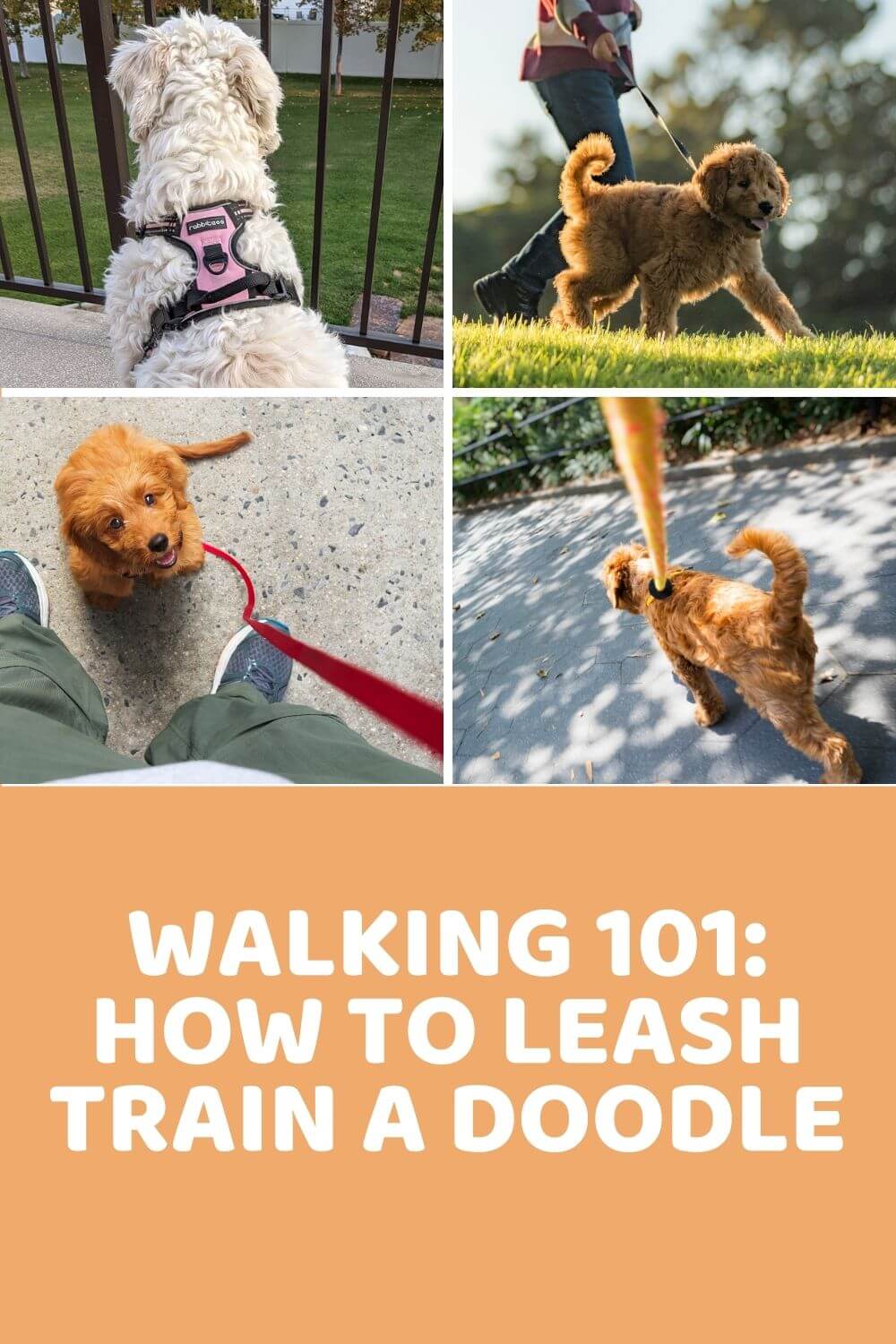Adopting a new puppy is an amazing experience. Bringing home that tiny, cute bundle of fur and introducing them to your family – it’s enough to make your heart melt. However, while dogs bring plenty of joy and love to a family, they are a full-time responsibility. They need a lot of care and attention, and a teething puppy is one of the earliest issues you will face and can be a touchy subject for new pet parents.
At this time, their previous sweet and gentle puppy will suddenly start nipping and chewing everything in sight. This intense but, thankfully, short-lived process can be arduous and plenty painful for pup. But what exactly is teething? When does it happen? And what can you do to help your pup through this painful process?
These are all questions we will address here so you and your pup can conquer this developmental stage with the bare minimum of muss and fuss. Let’s start by taking a look at why and when it happens:
Stages of Teething
Unlike human infants, a dog’s first teeth appear pretty early in their lives – somewhere between the ages of 2 and 4 weeks old. So, the earliest stage of teething will have happened long before you adopted your new puppy.
These initial 28 teeth are tiny but needle sharp, yet they don’t have all the strength and functionality of adult teeth. They are simply there to start helping them manipulate things with their mouths.
Then, at around 3 to 4 months, your puppy will start to lose these baby teeth to make room for their permanent ones, which will begin to erupt from their gums around the same time.
- Check out this picture of a pup’s two front teeth missing!
- Check out this picture of a found baby tooth!
- Check out this picture of a pup’s with almost all their adult teeth. Notice that the first molars just behind the canines are still erupting.
This process can be confusing and uncomfortable for your pup. However, it only takes around two to three months in total. So, by the time your puppy is 7 months old, all of their 42 adult teeth should be firmly in place, and teething will be over.
Symptoms of Teething
One of the most noticeable symptoms of teething is excessive mouthing and gnawing. While, just like babies, puppies tend to explore the world with their mouths, you will notice at this time that chewing and biting behaviors go to a whole other level.
The biggest issue with this is that your puppy is yet to learn what they can and can’t chew. Those delicate but razor-sharp teeth of those will tear through anything they can get their little paws on – clothes, furniture, table legs, skin…
While it can be very easy to get frustrated and annoyed with your puppy at this time – especially if they seem to be taking great delight in nipping at your fingers and ankles – try to keep in mind that teething can be incredibly uncomfortable for them. They are simply doing what nature intended them to do in order to speed along the process and ease the pressure in their gums.
Other symptoms of teething include drooling and bleeding. You may spot tiny bits of blood on their toys and bedding or even a baby tooth or two about the place. Don’t worry if you don’t, though; your puppy will swallow most of their baby teeth as they chew or eat.
Teething Toys for Your Puppy
One of the best things you can do for your puppy (and yourself) is to provide them with some appropriate chew toys during teething time. With these, they can let loose their biting and gnawing instincts without destroying your belongings in the process.
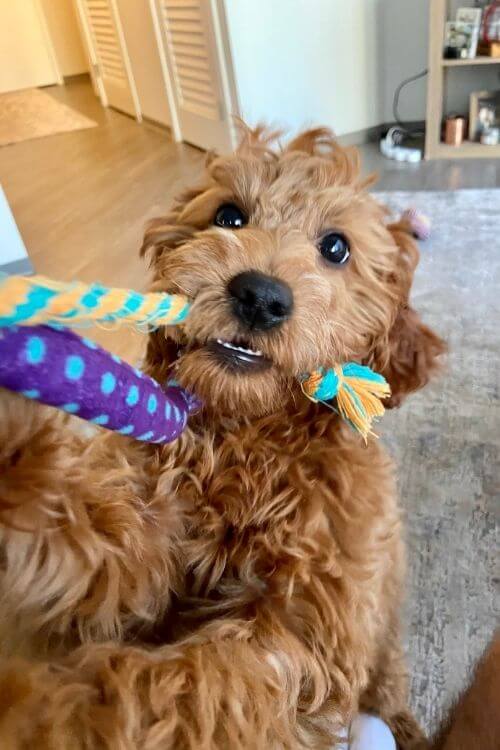
Alongside helping your puppy relieve their painful gums, an assortment of toys about the house enables them to start learning which items they can and can’t chew on. For this reason, you’ll want to avoid toys that are shaped like items you don’t want your pup to chew, such as squeaky shoes. Just keep in mind that having these doesn’t necessarily mean other things will be safe, so it’s best to keep temptation out of reach of your pup for a while.
These days there are plenty of toys on the market explicitly designed for teething puppies. Many of them are the perfect size for little puppy mouths. You will, however, need to ensure that you pick up the right one for the type you have, as dogs, even very young ones, differ significantly in size. Anything too small for your pup’s breed or age could be a potential choking hazard.
Such items have also usually been carefully manufactured to withstand teeny, tearing teeth but without being too firm as to cause more pain or injury as your pet chews. Look for something you can flex with your hand and indent with your finger, but not with total ease – if you could pull the item apart, so could your puppy.
Teething Toy Recommendations by Type
While having plenty of available options is a good thing, narrowing down the choices can be a little challenging. You want a well-built toy that will actually help your pup, but you also need to ensure that it won’t just be left lying around the house while they happily nibble away at your chair legs.
Luckily toy-designing experts have thought of that. Many toys come with additional ‘bells and whistles’ that will hopefully engage your pooch’s interest and hold on to it for a while. Everything from spaces to add treats, to squeakers and bounce has been covered – just not any actual bells and whistles as these would probably get chewed off anyway!
The features that will most appeal to your puppy will depend largely on their breed as well as their individual personality. Some dogs are naturally more active than others and will enjoy toys that they can play with either by themselves or with their owners, such as balls, frisbees, or rope toys.
Others will be happy to hunker down with something they can happily nibble on until their heart’s content. They may like toys that can provide comfort, such as soft toys or bone – like ones with interesting flavors, nubs, and other features to help reduce the pain in their gums as they chew.
Action Toys – Ones Dogs Can Play with Alone
By and large, Doodles are incredibly active dogs. For this reason, KONG’s Puppy Binkie often goes down a storm with its erratic bounce that has them hopping all over the place for hours on end. While this toy is also available for adult dogs, the puppy option is specifically designed for a growing puppy’s baby teeth and for supporting the transition to adult ones. To extend play, the toy can be stuffed with healthy treats for added enjoyment.
KONG Puppy Binkie Soft Teething Dog Toy
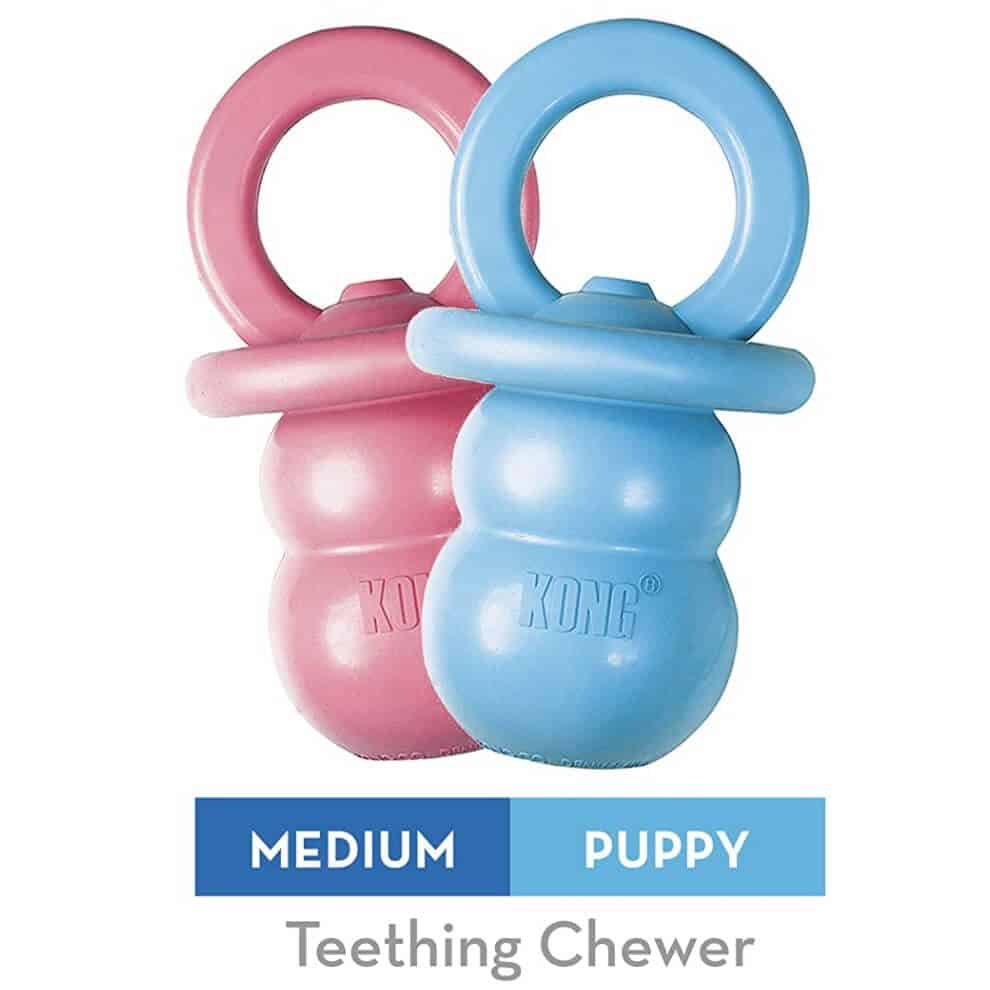
Reviewers comment that this toy is a good size, even for smaller pups. The treat section seems to be a particular hit with smart dogs as they need to figure out how to get at what’s inside. Pet parents also liked that you can freeze the treats inside the toy for extra gum-soothing effects, and the product is durable even with tough chewing. The unpredictable bounce is good for keeping dogs interested – but means that the toy should be kept far from any breakables.
Another handy option for self-play (or games of fetch, of course) is the Gnawsome Squeaker Ball Dog Toy. Although it’s not specifically for teething, or even for puppies, the food-grade rubber is soft enough for puppy teeth and gentle enough for sore mouths. In fact, the spiky texture of the ball massages gums while the bright colors and loud squeaker inside the ball keep active games fun for longer. Just make sure to pick up the right size for your pal.
Gnawsome Squeaker Ball Dog Toy
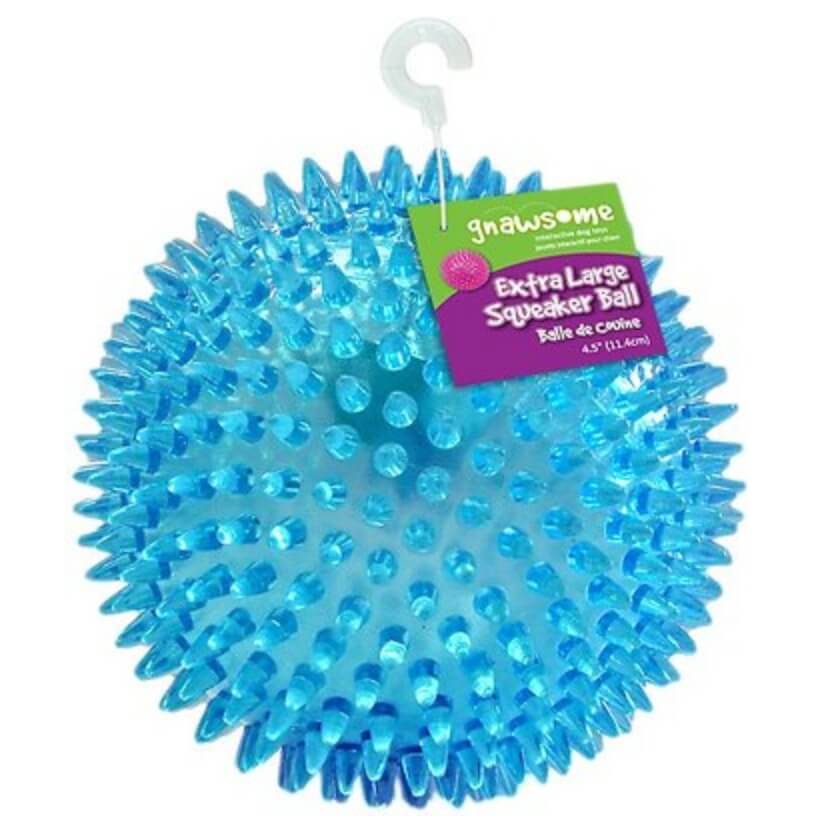
The excellent star ratings tell us that this is a popular choice among pet owners in the know. The balls are sturdily made and hold up well against chewing (which is really what you want in a chew toy, after all!), and they bounce well, too, keeping active pups engaged. Some comment that the squeaker is SUPER loud, though, which could get irritating – this might be best as an outdoor-only toy if that kind of thing bugs you too much.
Comfort Toys – Ones Dogs Can Quietly Chew On
For calmer Doods, or simply for quieter times, Nylabone’s Puppy Teething Dinosaur is an excellent choice. Specifically designed to support teething troubles in puppies up to 25 pounds, this chicken-flavored toy also helps promote more positive chewing habits. The bumpy exterior of the dino, with its massaging nubs, relieves pressure in your pup’s gums as they chew. You can also chuck the toy in the freezer for extra impact.
Nylabone Teething Dinosaur Puppy Chew Toy
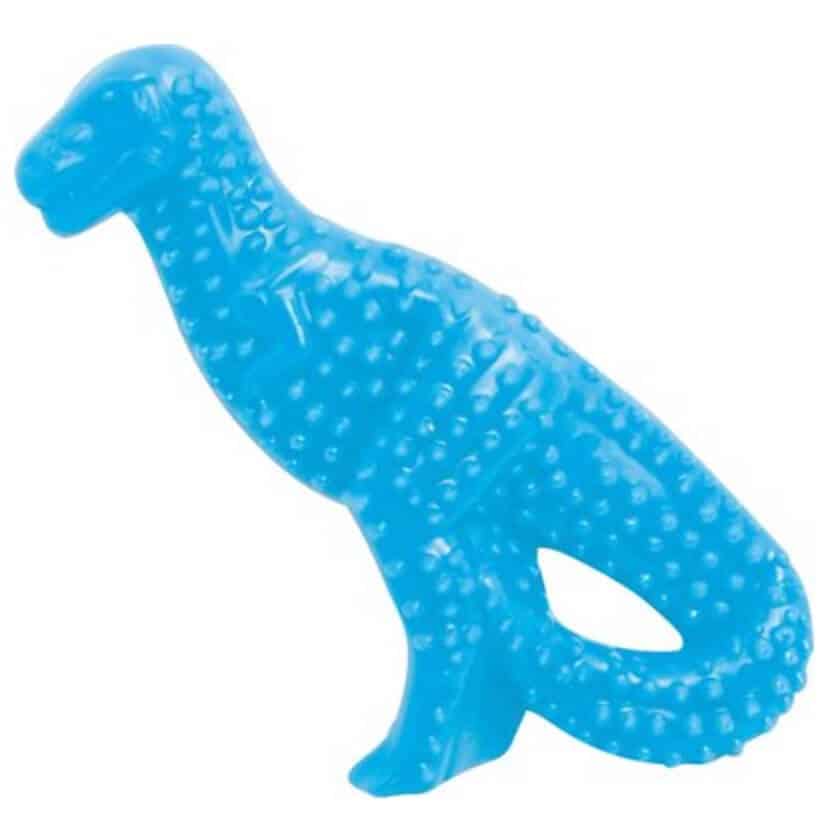
While this one has mixed reviews, many of the issues experienced by low raters are because they either ordered the wrong size (so make sure you refer to the manufacturer’s guide) or because they gave it to aggressive chewers, which the product is not intended for. Those using it with small or toy breeds that are a little more relaxed find it to be fun, practical, and often mention that it quickly became one of their pet’s favorite toys.
Pups that love a good cuddle will appreciate Zoobilee’s Squatter Panda & Rabbit Plush Puppy Toys. Perfect for puppies and other small dogs, these adorable plush characters are uniquely constructed to last and last… even when subjected to gnawing and scratching. Made with washable synthetic materials, the toys include a fun squeaker to make playtime even more enjoyable. When your pup is done working their gums, they can curl up for a snooze next to their new best friends.
Zoobilee Squatter Panda & Rabbit Plush Puppy Toy
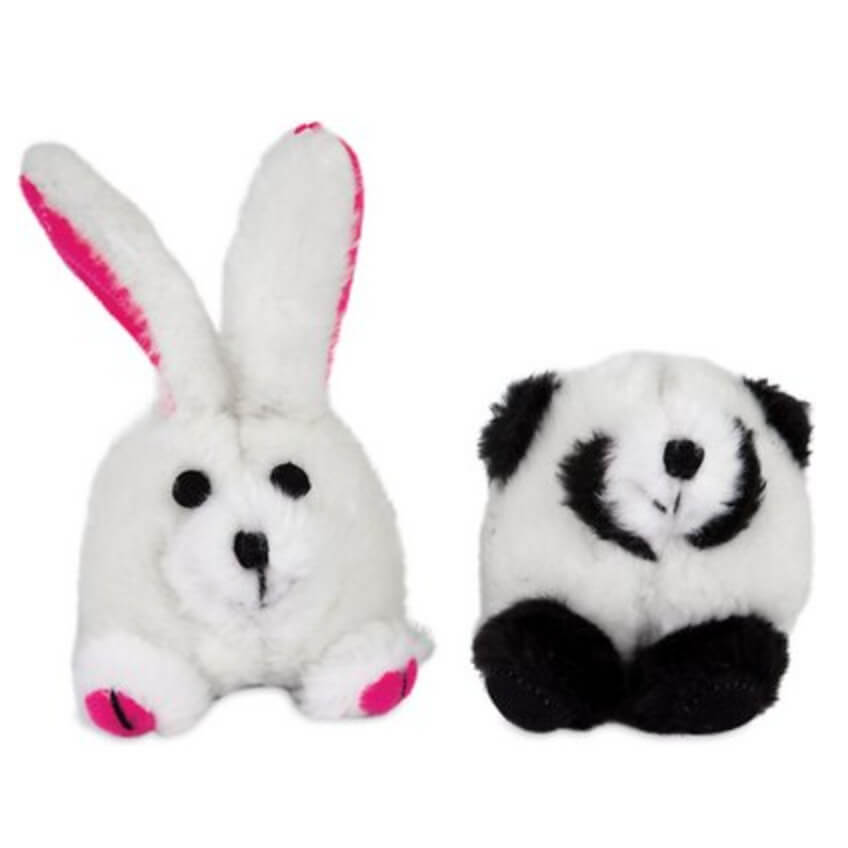
Reviews are overwhelmingly positive for these excellent teddies with ‘loves,’ ‘loves,’ ‘loves’ right across the board. They are also affordable and sturdy, meaning you won’t have to keep replacing them when they do become your pal’s favorite toys. Again, these wouldn’t be ideal for a hyper-active super chewer, but they are great for more soft-spoken small to medium breeds. Just be sure to check the size, as some people have commented that these are smaller than expected.
Distraction toys – Ones for Interactive Play
Bonding is a crucial part of play, and many manufacturers keep this in mind when designing teething toys. KONG’s Puppy Tires Dog Toy is great for games of fetch. The ring is easy for puppies to grip as they carry, roll or chew it. Just like the other Kong toy included above, the Puppy Tire has an unpredictable bounce which means it zigs and zags all over the place when thrown for endless hours of fun. In terms of teething, the material is soft yet durable and suitable for freezing too.
KONG Puppy Tires Dog Toy
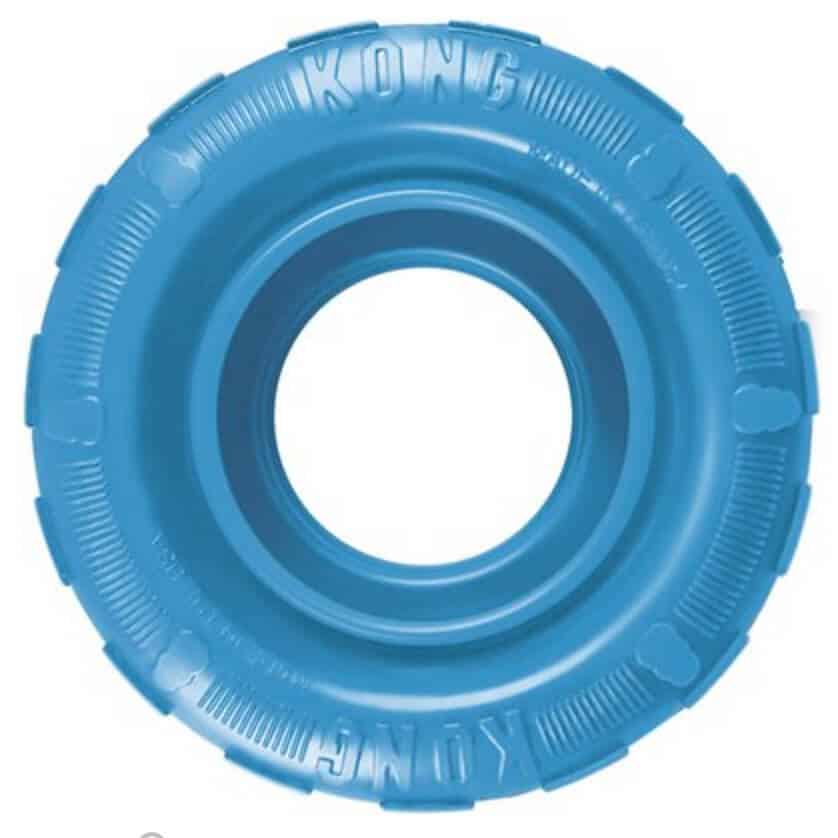
Doodle (as well as other breed) owners appreciate this toy and the fact that it can also be stuffed with training snacks and kibble to make it even more enticing. This means they can get a little more time to themselves as their pet works out how to get to the good stuff. Keep in mind that this toy size is suitable for puppies and so it may not work out so well for older dogs.
For something a little different, HuggleHound’s Corduroy Knottie Bunny Squeaky Dog Toy is perfect for gentle games of tug-of-war between you and your pet. These can help distract them from their mouth hurts in their enthusiasm for the game. The machine-washable toy features no less than five squeakers for fun and exciting games as they tug and shake at the poor bunny. The ultra-soft exterior makes it perfect for cuddling up to when playtime is done.
HuggleHounds Corduroy Knottie Bunny Squeaky Dog Toy
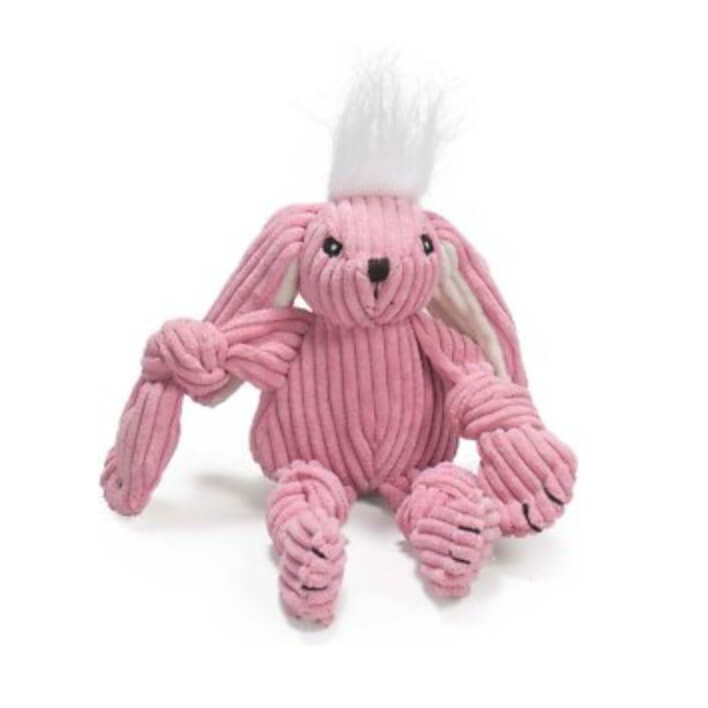
Despite the delicate appearance of the toy, reviewers were impressed with its toughness, thanks to the signature Tuffut Technology for extra durability. Moreover, many mentioned that their pets loved these cute teds so much that they had to order a replacement (after a good long while of loving) before they could even attempt to take the old one away. This toy would certainly get two doggy thumbs up…if dogs actually had thumbs, that is.
What Not to do With Your Teething Puppy
While toys can be a great way to distract your puppy and allow them to self-soothe, giving you some much-needed downtime, you should never leave your pup unattended with their toys.
Well-made options are certainly sturdy but not indestructible – especially if you have had them for a while and they have seen plenty of action. It just takes a little bit of weakness, and suddenly, your pup is pulling apart and devouring their toy. This could lead to some pretty severe health complications.
Make sure that you are regularly inspecting your pet’s toys to ensure that they are still in one piece and likely to remain so. Any serious signs of wear and tear, such as weaknesses in fabric or sharp edges on plastics, and you will need to take them away and replace them.
Never give your dog toys that weren’t designed for dogs, such as stuffed animals or baby toys. These are often not durable enough to withstand rough-and-tumble puppy play in the way that ones made especially for canines can. Not only will your pet likely damage the toy, but small parts they pull away from it could be a choking hazard or contain materials not safe for consumption.
How to Control Nipping Behaviors
Puppies naturally nip as part of their play behavior. They do it to other dogs and likewise to any people they play with – until they learn better. In their excitement, they often don’t realize exactly how hard they are biting.
As their doggy friend would caution them with a yip, so too can you let your pain verbally be known by them. When your puppy bites you during play, say “ow!” loudly and then stop playing with them. This helps them to master bite control, learning what they can and can’t do and how not to hurt you with their mouthing.
However, some dogs may get more worked up by the loud noise. If this is the case for your dog, simply turn from them and walk quietly away. In this way, they will get the same message – that playtime will stop when they bite too hard. This helps them to understand not to do this.
At this point in their development, your puppy is learning something called bite inhibition. This is where they moderate the force of their bite, so it is appropriate to the given situation.
Yet, as we’ve covered above, chewing behaviors go to excess during teething. If you think this is the case with your dog, then when they start to use their teeth, simply redirect their attention away from your fingers towards one of their newly purchased teething toys. Bringing these items into your games serves to encourage your pup to use them.
If that doesn’t work, you may need to redirect some of your dog’s playful energy into another activity such as a walk, outdoor play, or even a training session. This will tire them out and help them to calm down a little.
Be aware that not all biting behavior is linked to play or teething. If your dog snaps at you, they are letting you know that they feel scared or uncomfortable in that moment. In many cases, this is a one-off, and it helps you to establish your own boundaries with your dog. However, if you notice that they are doing this with increasing frequency, or if their bites become more severe, it could indicate the presence of an underlying issue such as pain or excessive anxiety, and you should take them to see the vet.
Post-Teething Care
Even though teething will be done by 7 months, that doesn’t necessarily mean that chewing will be. Some breeds are naturally chewier than others, so it pays to do a little research to see what you’re in for.
The good news, however, is that if you have followed the above advice, you will already have established a clear routine – your dog will know what they can and can’t chow down on. One thing you will likely need to do, though, is switch out your dog’s puppy toys for ones more suitable for adult teeth.
While some owners may prefer to discourage chewing altogether, this behavior is actually a great way for your pup to keep their teeth clean and their gums healthy. Combine it with regular brushing and dental treats, and your pet should have absolutely no problems with their gnashers for the rest of their life.
Puppy Teething: Frequently Asked Questions
How long does teething last in puppies?
Teething happens almost all at once (which is why it can be so painful for your poor puppy). From the age of about 3 or 4 months, they will start to lose their first set of 28 teeth to make room for the 42 permanent ones. This takes somewhere between two and three months. Your dog will be done with teething, at the latest, by the time they are 7 months old.
How can I help my puppy with teething?
Support your pup’s teething by providing them with plenty of chews. Both treats and toys are fine, although you need to be mindful of the number of calories they are getting throughout the day. Placing toys in the freezer (if they are of a suitable material) can also help to reduce any pain or discomfort caused by new teeth pushing through your pet’s gums.
Do puppies bite more when they are teething?
Chances are you will find your puppy more inclined to bite and nip while they are teething. Rather than punishing them, which will only serve to make them either fearful or aggressive later on in life, redirect their biting to an appropriate nearby chew toy. If this behavior is constant during playtime, discourage it with a loud ‘ow!’ and by turning away from the game. Your dog will associate this behavior with the removal of something they enjoy – your attention – and will be less likely to repeat it.
From the age of around 3 to 4 months, your adorable little angel may morph into the chewing demon from hell as they begin teething. The discomfort of this would be enough to bring out the monster in anyone! You may start to find tiny tooth marks in everything from doors to clothes to your fingers.
Avoid this issue by being prepared with fun, tempting chew toys that they can really get their teeth into. These will help to soothe their aching gums and distract them from the nagging pain they will be feeling at this time.
Selecting the right kind of toy for your pup might seem like a challenge, but if you aim to get one that suits his breed and unique temperament, you won’t go far wrong. Hopefully, the recommendations given here, based on hundreds of dog owner reviews, prove useful for doing just this.
Learn How to Care for Your Doodle Puppy!

Perfect for first-time Doodle parents, get ALL your questions answered, including questions new Doodle parents don’t even think to ask.
Plus, get $700 worth of Bonus Materials for FREE, including:- Doodle Parenthood Community and Support Group ($190 value)
- Doodle Puppy Growth Tracker ($20 value)
- EMERGENCY Cheatsheet: When To Call The Vet Immediately ($50 value)
- HELP! Button ($145 value)
- And SO MUCH MORE!
The information on this page is for informational purposes only. It is not intended to be a substitute for qualified professional veterinary advice, diagnosis, or treatment. Always seek the advice of your veterinarian or other qualified animal health provider with any questions you may have.

